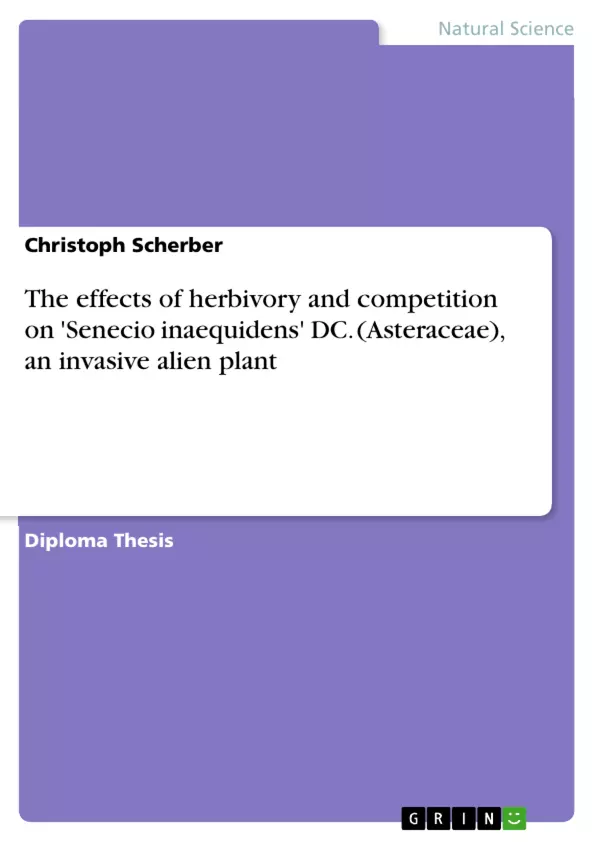Since the end of the 19th century, overall per-capita mobility of humans has increased significantly, leading to increased rates in human-mediated transportation of animal and plant species. The rapid spread of alien organisms, however, may lead to quick and unpredictable changes in ecosystems.
Senecio inaequidens DC. (Asteraceae) is an invasive alien plant from South Africa that was first introduced to Europe 100 years ago and is characterized by an exceptionally fast rate of spread; it contains pyrrolizidine alkaloids that are toxic to invertebrates, livestock and humans.
In the study presented here, laboratory, greenhouse and field experiments on the biology of Senecio inaequidens were conducted, in order to find out if and how herbivory and plant competition influence growth, survival and reproduction of this plant. Specifically, the presence of vertebrate herbivores, molluscs, insects and plant competitors was experimentally manipulated using full factorial and split-plot designs. All experiments were performed at Imperial College, Silwood Park, about 30 km west of London (UK).
Growth and fecundity of Senecio inaequidens were significantly affected by interspecific competition. Vertebrate herbivory only had a significant effect when a closed vegetation cover was present. On artificially disturbed plots, Senecio inaequidens showed high capability to overcompensate for herbivory. Mollusc herbivory significantly reduced fecundity of S. inaequidens. Different ecotypes of Senecio inaequidens showed different amounts of herbivore damage.
One of the most remarkable results of this study was that Longitarsus jacobaeae, a native specialist leaf beetle, freely colonized Senecio inaequidens, indicating that native herbivores might be suitable biocontrol agents of invasive alien plants in the future. Host switching from indigenous to invasive alien plant species in oligophagous insect herbivores may be more common than generally thought.
The results of this study indicate that Senecio inaequidens is likely to invade and persist in heavily grazed or disturbed grassland ecosystems in the near future; because of the toxic compounds this plant contains, it would be advisable to design a preventive management program and to inform the public about the consequences that might be associated with the invasion of this plant.
Inhaltsverzeichnis (Table of Contents)
- Abstract
- Zusammenfassung
- Acknowledgements
- Declaration
- Introduction
- Materials and Methods
- Experimental design
- Plant material
- Seed collection
- Seed germination
- Seedling production
- Experimental treatments
- Herbivory
- Interspecific competition
- Field experiments
- Clipping experiments
- Mollusc herbivory
- Greenhouse experiment
- Laboratory experiments
- Two-way feeding preference experiments
- Damage estimation
- Statistical analysis
- Results
- Field experiments
- Clipping experiments
- Mollusc herbivory
- Greenhouse experiments
- Laboratory experiments
- Two-way feeding preference experiments
- Discussion
- Herbivory
- Interspecific competition
- Evolutionary aspects of host-plant selection
- Implications for the invasion process
Zielsetzung und Themenschwerpunkte (Objectives and Key Themes)
This diploma thesis investigates the influence of herbivory and plant competition on the growth, survival, and reproduction of the invasive alien plant Senecio inaequidens DC. (Asteraceae). The primary objective is to assess the effects of various herbivores, including rabbits, molluscs, and specialist insect herbivores, on the invasive potential of Senecio inaequidens.
- Impact of herbivory on Senecio inaequidens growth and reproduction
- Influence of plant competition on the invasive success of Senecio inaequidens
- Host plant selection by specialist insect herbivores and its implications for invasion
- Ecological and evolutionary factors driving the invasion of Senecio inaequidens
- Management strategies for mitigating the spread of this invasive plant
Zusammenfassung der Kapitel (Chapter Summaries)
The thesis begins with an introduction detailing the increasing problem of invasive alien species, focusing on the specific case of Senecio inaequidens. It then outlines the materials and methods used in the study, including experimental designs, plant material, and herbivore species. The results section presents data from field, greenhouse, and laboratory experiments, evaluating the effects of herbivory and competition on Senecio inaequidens growth, survival, and reproduction.
The discussion chapter delves into the ecological implications of the findings, exploring the relationships between herbivory, competition, and the invasion dynamics of Senecio inaequidens. It also considers the evolutionary aspects of host plant selection by insect herbivores and the potential for management strategies to mitigate the spread of this invasive plant.
Schlüsselwörter (Keywords)
The thesis focuses on the following key concepts: invasive alien plants, Senecio inaequidens, herbivory, plant competition, host-plant selection, insect herbivores, ecological dynamics, invasion biology, management strategies.
- Arbeit zitieren
- Dr. rer.nat. Christoph Scherber (Autor:in), 2002, The effects of herbivory and competition on 'Senecio inaequidens' DC. (Asteraceae), an invasive alien plant, München, GRIN Verlag, https://www.hausarbeiten.de/document/8982


